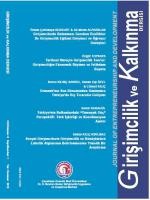The Asymmetric Relationships Between Hedge Funds and Financial Indicators: Evidence From Turkey
Hedge funds, Financial indicators, Financial assets, Hatemi-J assymetric causality
___
- Ozer, H. A., Yagcıbası, O. F., & Karaoglan, S. (2017). Asymmetric Causality between Economic Growth and Military Expenditures: The Case of Turkey. The Empirical Economics Letters, 900-907.
- Soyaslan, E. (2019). Analysis of The Relationship Between Exchange Rate and Bist Tuorism Index. International Journal of Society Researches, 774-793.
- Yang, E., Kim, S. H., Kim, M. H., & Ryu, D. (2017). Macroeconomic shocks and stock market returns: the case of Korea. Journal of Applied Economics, 757-773. Zhou, A. (2019). Hedge Funds' Strategies and Their Market. University of Milano-Biccoca, 2-38.
- ISSN: 1306-8946
- Başlangıç: 2015
- Yayıncı: Çanakkale Onsekiz Mart Üniversitesi
COVID-19 Salgınının Türkiye’deki Girişimciler ve Faaliyetleri Üzerinde Etkileri: Nitel Bir Araştırma
The Asymmetric Relationships Between Hedge Funds and Financial Indicators: Evidence From Turkey
Serap KAMIŞLI, Neslihan KOCADAYI, Mustafa HAMAD AMEEN
Darülaceze Başkanlığı Çalışanlarının Örgütsel Bağlılık ve İş Tatminleri Üzerine Bir Araştırma
Cansu ALAYVAZ, Bedrettin KESGİN
Mustafa TORUN, Hakan ÇETİNOĞLU
Kalkınmacı Devlet Yaklaşımı Bakış Açısından Sanayi Politikası
MAKROEKONOMİK DEĞİŞKENLERİN BORSA İSTANBUL HİZMETLER ENDEKSİ (XUHIZ) ÜZERİNE ETKİLERİ
Ethem ESEN, Selim YILDIRIM, Fatih TEMİZEL, Gizem KÜTÜKCÜLER
Seçilmiş Değişkenlerin Doğrudan Yabancı Yatırımlara Etkisi: Türkiye Örneği
